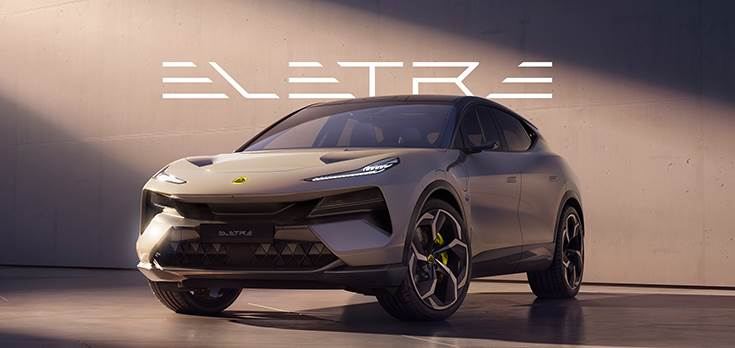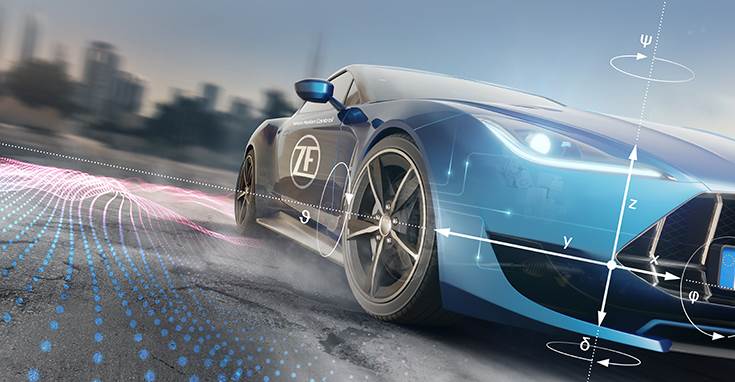The Lotus Eletre has become the world’s first production vehicle to be equipped with ZF’s new cubiX automotive software, which facilitates intelligent networking of all chassis systems for optimally controlled longitudinal, lateral and vertical dynamics that are essential for a pleasant driving experience.
This is especially true for automated driving, when the driver turns away from active driving and the focus is on comfort. This is where ZF’s cubiX software comes into play – it controls all chassis systems and ensures harmonious acceleration and braking, precise steering, and balanced damping.
The Geely Group’s Lotus Eletre electric SUV from the Geely Group has been delivered to the first customers since February. From the middle of the year, the vehicle will be available in Europe. ZF’s software controls all chassis functions such as brakes, front and rear axle steering, and active roll stabilisers as well as the electric drive of the new sports car. Further production start-ups of the innovative ZF software will follow from 2023.
“With the series premiere of our cubiX software, we impressively demonstrate our system competence for vehicle dynamics of software-defined vehicles,” says Andre Engelke, Head of the Vehicle Motion Control System House at ZF. “We can harmoniously control the entire longitudinal, lateral and vertical dynamics of the vehicle according to Lotus’ specifications. The system know-how from the entire ZF Group meets decades of experience in the fields of braking and steering systems, active dampers, and driveline technology.”
 ZF’s cubiX control software interlinks and coordinates the active and semi-active actuators with a control algorithm.
ZF’s cubiX control software interlinks and coordinates the active and semi-active actuators with a control algorithm.
Conductor for vehicle dynamics
The cubiX software optimises driving behaviour with a view to comfort, dynamics and efficiency and also forms the basis for progressive driver assistance systems. As ZF’s first pure software product, cubiX offers another decisive advantage: The platform is compatible with various actuators such as dampers, brakes or rear-axle steering – regardless of the manufacturer or the specific design. This gives manufacturers the flexibility to implement different model series with one and the same control platform without additional integration effort.
Future updates or upgrades to the software can be carried out ‘over-the-air’ – i.e. wirelessly without a visit to the workshop. In this way, the software remains up to date throughout the vehicle’s life, meaning that additional functions can always be added after the vehicle has been delivered.
Architecture change in the Software-defined Vehicle
cubiX is an example of a decisive trend on the way to the software-defined vehicle: away from the many individual controls of hardware components, towards overarching domain and zone architectures.
This development takes into account the increasing complexity of automotive control software. Until now, dampers, brakes or rear-axle steering have each had their own control unit that has had to be integrated into the overall architecture of the vehicle.
The new electrical and electronic vehicle architectures bundle all the software for a specific functional area of the car – known as the domain – on a central control unit. “This overarching control saves vehicle manufacturers effort as well as compromises in fine-tuning and driving dynamics in terms of vehicle performance, comfort and efficiency. At the same time, it gives them the chance to combine complex assistance systems,” explains André Engelke. “With cubiX, we have such software that can be perfectly integrated into the new architectures.”
IcubiX was developed at multiple ZF sites globally (Germany, Czech Republic, Romania, UK, India, and China), the application project driven out of Region Asia Pacific.
Eletre-fying performance
The all-new, all-electric SUV has three different versions are available – Eletre, Eletre S and Eletre R – with a choice of two powertrains. Eletre and Eletre S both feature a 603hp (450kw) single-speed unit producing 710Nm of torque to deliver a 0-62mph/100kph time of 4.5 seconds and a maximum range of 373 miles / 597km.

The flagship Eletre R comes equipped with a 905hp (675kw) dual-speed set-up boasting 985Nm for 0-62mph/100kph in just 2.95 seconds, making it the world’s fastest pure electric dual-motor SUV. Maximum range for this performance-oriented variant is 304 miles/486km, while the 112kWh battery found in all versions can be charged (10%-80%) in just 20 minutes using a rapid charger.
Inside, the Eletre’s premium cabin sets a new standard of desirability for Lotus interiors. The Eletre comes with 12-way electrically adjustable front seats, four-zone automatic climate control, Apple CarPlay/Android Auto, wireless phone charging and much more. Its advanced ‘digital cockpit’ features server-level computing power, enabling a billion-colour OLED touchscreen to display the cutting-edge Lotus Hyper OS for next-generation real-time 3D content.
ALSO READ: ZF Group to quadruple global component sourcing spend in India to 2 billion euros by 2030
